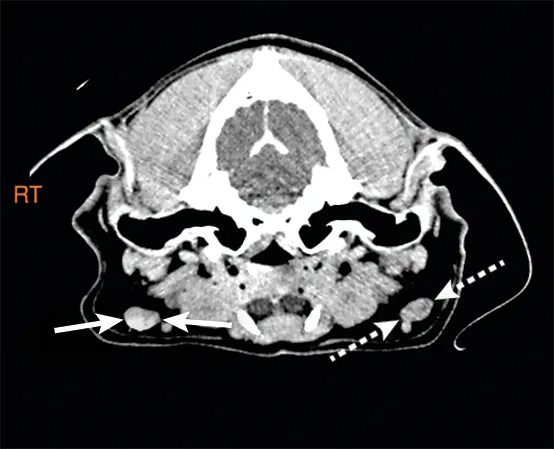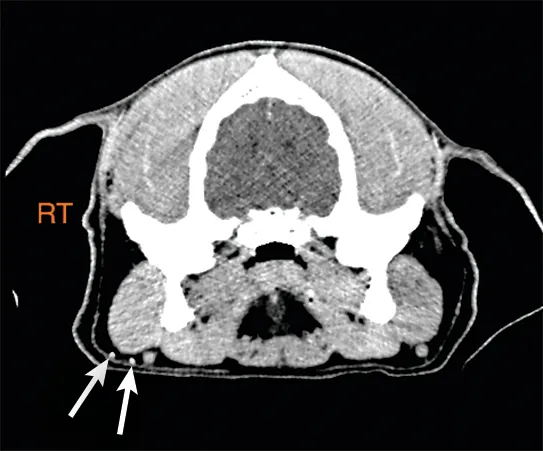Biopsy of Sentinel Lymph Nodes After Injection of Methylene Blue & Lymphoscintigraphic Guidance
Sarah Boston, DVM, DVSc, DACVS, ACVS Founding Fellow of Surgical Oncology, ACVS Founding Fellow of Oral & Maxillofacial Surgery, VCA Canada, Newmarket, Ontario, Canada
In the literature
Ferrari R, Chiti LE, Manfredi M, et al. Biopsy of sentinel lymph nodes after injection of methylene blue and lymphoscintigraphic guidance in 30 dogs with mast cell tumors. Vet Surg. 2020;49(6):1099-1108.
The Research …
The sentinel lymph node (SLN) is the first lymph node that receives afferent drainage from a primary tumor and is expected to be the first site of metastasis for tumors that spread via the lymphatics.1 SLN mapping and biopsy are important for staging and treatment in many human cancers and have recently gained increased attention in veterinary medicine. Several veterinary studies have shown that palpation characteristics and cytology may not reflect true lymph node status.2-5
Both epithelial and round-cell tumors commonly metastasize via the lymphatics. Canine mast cell tumors (MCTs) are an important tumor type to focus on in veterinary studies, as they are common, and lymph node status is an important part of staging and developing recommendations for treatment. In one retrospective study of canine MCTs, the rate of metastasis to local lymph nodes was 30.9%, and no dogs had evidence of metastasis to more distant sites if local lymph node status was negative,6 which is also an important determinant of prognosis.7
There are several methods to evaluate the SLN in veterinary medicine; these generally involve injecting the primary tumor with a marking agent then following the agent as it travels along the lymphatics to the first draining lymph node. One method that can be performed in general practice is injection of the tumor with a lipid-based contrast medium, followed by radiography of the region within 24 hours.8 A similar method employs the use of CT after peritumoral injection of an iodinated-contrast medium (Figures 1 and 2).9
The first study to evaluate SLNs in dogs with MCTs demonstrated that the SLN was not the expected regional lymph node (RLN) in 8 out of 20 tumors.10 That study used a combination of lymphoscintigraphy and new methylene blue to identify and extirpate the SLN. The present study used a similar technique, with SLN detection and extirpation guided by radionuclide and methylene blue injections in dogs with cutaneous and subcutaneous MCTs. This study included 30 dogs with a combined total of 34 MCTs that were amenable to wide surgical resection and negative for staging with RLN palpation and ultrasound-guided aspiration of the spleen and liver. Technetium-99 was injected peritumorally in anesthetized dogs, and the region was imaged using a γ camera. Dogs were then prepared for surgery, and methylene blue was injected peritumorally. Tumors were excised with curative intent, with 2 to 3 radial margins and at least one fascial plane deep. A handheld γ probe was used to identify the SLN; methylene blue assisted with surgical identification of the SLN for removal.
At least 1 SLN was identified in 31 out of 34 tumors (91.2%). All SLNs were blue stained, and there were no blue-stained lymph nodes without radioactivity, with a correlation of 100% between radioactive and methylene-blue–stained lymph nodes. The SLN correlated with the expected RLN in 11 out of 30 cases and did not correspond to the clinically expected RLN in 13 out of 30 cases. There was only partial correspondence of the SLN and RLN in 6 out of 30 cases, meaning there was >1 SLN in these cases. Early (26 out of 57) or overt (6 out of 57) metastasis was found in 56.1% of the identified lymph nodes. Cases in which the SLN could not be identified had scar tissue at the primary tumor or lymph node site.
SLN assessment is likely more critical in cases with a higher chance of metastatic disease. MCTs can be challenging to treat because of the margins needed and because the likelihood of metastasis depends largely on tumor grade. In most cases, the preoperative diagnosis is cytologic, but there are no methods to grade MCTs based on cytology. Two studies investigating a cytologic grading scheme for MCTs were not completely accurate when compared with final histopathology, and both studies assigned MCTs with a grade that was too high or too low.11,12 This is an area of active investigation. Once a reliable method is available it will aid in identifying which MCTs may be better referred for more aggressive staging, SLN mapping, and wider excision.

CT scan of the head of a dog with an oral tumor after periotumoral injection of iodinated contrast material, which can be seen in the right mandibular lymph node (solid arrows) as compared with the left mandibular lymph node (dashed arrows), indicating the right mandibular lymph node is the SLN.

CT scan of the same dog in Figure 1. This image is cranial to that shown in Figure 1 and shows the iodinated contrast material in the lymphatics (arrows) as it travels to the SLN.
… The Takeaways
Key pearls to put into practice:
Knowledge of lymph node status is important in staging and treating dogs with MCTs. The RLN is not always the SLN, so it is possible to incorrectly stage a patient and miss lymph node metastasis if only the RLN is sampled.
The technique reported in this study is effective but less practical, as it uses scintigraphy. Injection with lipid-based contrast media, followed by radiography, for SLN mapping could be considered in practice.
Cytologic grading of MCTs is not yet available, but when it is, it will have important implications for the staging and treatment of MCTs, including when SLN mapping should be performed.